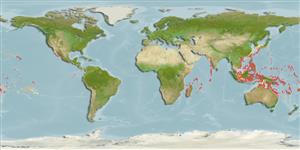Environment: milieu / climate zone / depth range / distribution range
Ecologia
marino associati a barriera corallina; non migratori; distribuzione batimetrica 1 - 30 m (Ref. 9790). Tropical
Indo-Pacific: East Africa to the Marshall Islands and Fiji (Ref. 2334). Northwards to Taiwan and Ryukyu Islands, including Mariana, Marshall, and Caroline islands (Ref. 1602, 37816).
Size / Peso / Age
Maturity: Lm ? range ? - ? cm
Max length : 37.0 cm TL maschio/sesso non determinato; (Ref. 9790); common length : 25.0 cm TL maschio/sesso non determinato; (Ref. 9790)
Short description
Morfologia | Morfometria
Spine dorsali (totale): 9; Raggi dorsali molli (totale): 11-13; Spine anali 0; Raggi anali molli: 11 - 13. Lips smooth, lacking papillae on edges. Least interorbital width going 3.5 times or less in greatest diameter of orbit. Base of lower opercular spine concealed by scales. Anterior 1-3, usually 2, lateral line scales bearing a small spine. Iris lappet bearing short branches with bifurcate tips.
Taken over sand associated with rocks and coral reefs to about 30 m (Ref. 9790). Buries itself partially in the sand for camouflage. Feeds mainly on crabs and prawns, also on fishes. Also found in sandy fringe of coral reefs (Ref 90102).
Life cycle and mating behavior
Maturità | Riproduzione | Deposizione | Uova | Fecundity | Larve
Randall, J.E., G.R. Allen and R.C. Steene, 1990. Fishes of the Great Barrier Reef and Coral Sea. University of Hawaii Press, Honolulu, Hawaii. 506 p. (Ref. 2334)
IUCN Red List Status (Ref. 130435)
Threat to humans
Harmless
Human uses
Pesca: di nessun interesse
Informazioni ulteriori
Nomi ComuniSinonimiMetabolismoPredatoriEcotossicologiaRiproduzioneMaturitàDeposizioneSpawning aggregationFecundityUovaEgg development
Age/SizeAccrescimentoLength-weightLength-lengthLength-frequenciesMorfometriaMorfologiaLarveDinamica popolazioni larvaliReclutamentoAbbondanzaBRUVS
BibliografiaAcquacolturaProfilo di acquacolturaVarietàGeneticaElectrophoresesEreditarietàMalattieElaborazioneNutrientsMass conversion
Strumenti
Special reports
Download XML
Fonti Internet
Estimates based on models
Preferred temperature (Ref.
123201): 24.6 - 29.3, mean 28.1 °C (based on 2283 cells).
Phylogenetic diversity index (Ref.
82804): PD
50 = 0.5625 [Uniqueness, from 0.5 = low to 2.0 = high].
Bayesian length-weight: a=0.00525 (0.00246 - 0.01120), b=3.04 (2.85 - 3.23), in cm total length, based on LWR estimates for this (Sub)family-body shape (Ref.
93245).
Trophic level (Ref.
69278): 3.8 ±0.66 se; based on food items.
Resilienza (Ref.
120179): Medio, tempo minimo di raddoppiamento della popolazione 1.4 - 4.4 anni (Preliminary K or Fecundity.).
Fishing Vulnerability (Ref.
59153): Low to moderate vulnerability (27 of 100).
Nutrients (Ref.
124155): Calcium = 54.8 [27.6, 146.9] mg/100g; Iron = 0.621 [0.286, 1.425] mg/100g; Protein = 17.9 [15.8, 19.9] %; Omega3 = 0.127 [0.057, 0.356] g/100g; Selenium = 34.2 [17.2, 89.1] μg/100g; VitaminA = 82.4 [30.0, 212.1] μg/100g; Zinc = 1.18 [0.76, 1.80] mg/100g (wet weight);
